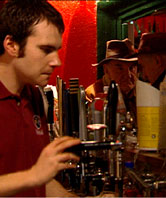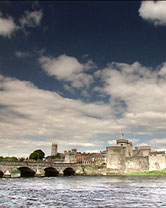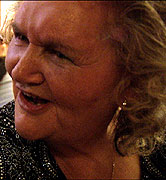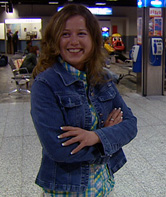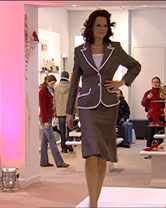By David McWilliams
Gill & Macmillan ©2005
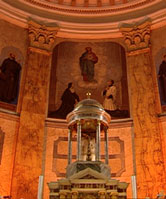
One of the clear losers in the Celtic Tiger boom is the Catholic Church. At the center of the “Mixed Blessings” program is a tale of the sale of Limerick’s Sacred Heart Church. Credit: Emmet Harte |
In the last 15 years, the Republic of Ireland has seen a dramatic economic renaissance that has catapulted its economy into the ranks of the richest in Europe. Rapid change has been a mixed blessing, however, as the march of progress overwhelms much of the traditional charm that has been Ireland’s trademark for decades. The questions facing Ireland today, and explored in this site’s features are these: Are progress and tradition compatible? Can Ireland maintain its new standard of living, or will it just be a flash in the fatalistic Irish pan? How will new immigrants to the Republic and the Irish cousins in the six counties north of the border join in the party?
In his book, THE POPE’S CHILDREN, Irish economist David McWilliams describes the phenomenal growth, eye-popping excess, and frenetic pace of life in today’s Ireland. In the first chapter, edited and excerpted below, he paints a vivid picture of the lives and lifestyles of the generation reveling in the bounty of the Celtic Boom.
** Words bolded in this essay can be found in the Glossary
.
The Full-On Nation
Ireland has arrived.
We are richer than any of us imagined possible 10 years ago. No Irish person has to emigrate, none of us need pay for education, and even our universities are free. Unemployment is the lowest in our history. We have more choice than ever, the place is more tolerant, and no one can be legally discriminated against. We have more cash in our back pockets than almost anyone in Europe. We are better off than 99 percent of humanity. We are top of foreigners’ lists of places to live. Unlike many of our rich neighbors, in survey after survey we claim to be very happy. We no longer need to beg from others in the EU; in fact, we are giving them cash. We are a success. We have money and time. We can now afford to kick back and take stock, reflect, and relax a bit. Why not go for a walk, be frivolous, or just stop the clock and slow down? The hard part is over. Or at least that’s what you might think. If economists ruled the world, they would say that Irish people would react to their newfound elevation by behaving rationally. We would take more days off, spend time with our families, and chill out.
But instead of winding down and luxuriating in our newfound wealth, we are accelerating as never before. We have to be there first, have the best, the brightest, the newest, and the biggest. We must also be the ones who are most fun, loudest, best craic, and the most off our head. We are borrowing, spending, shopping, shagging, eating, drinking, and taking more drugs than any other nation. We are Europe’s hedonists and the most decadent Irish generation ever. Interestingly, this carry-on is ubiquitous. At one end of the scale, Irish teenagers are losing their virginity and taking drugs earlier, while at the other end of the scale, our forty- and -fiftysomethings are binge drinking, swinging, and hoovering cocaine to allow them to stick the pace and have one last drink. We are the full-on nation.
We are eating more than ever, obsessing about food, writing about it, and savoring it. We are in ingestion heaven. We are getting fatter, quicker. Not so long ago, we were skinny and all our hard men were wiry little fellas. Growing up in Dún Laoghaire in the 1980s, I remember all the hard men were sinewy, scrawny lads, hence the local description “more meat on a seagull.” The reason was simple: they were undernourished. Perched on the church wall in the town were skinny, arseless lads, spitting and smoking. The young wans, despite a couple of babies, were more or less the same, pinched, flat-chested, and drawn. Today, Dún Laoghaire’s hard men are fat. Rolls of flab strain the Liverpool away strip. Double chins are de rigueur and little piggy eyes are squeezed into sockets among the flab. Gravity has also got the better of the young wans, as their corpulent bums, like two puppies in a bag, make unsightly bids for freedom over their entirely ill-advised ultra low-rise jeans.
According to the national task force on obesity, 30 percent of Irish women are overweight and a further 12 percent are obese, while nearly half of Irish adult males are overweight and 14 percent are obese. We are gorging ourselves into an almost certain diabetes epidemic. Even our babies are coming out bigger. We are turning into a race of sumo wrestlers, with 20 percent of our infants weighing more than 10 pounds when they are delivered — up 400 percent from the same figure in 1990. Is this any surprise when we spend more on crisps than on pharmaceutical drugs? According to the latest household budget survey, our spending on chip shops and takeaways went up by over 70 percent in the past seven years. We also increased spending on sweets by just over 50 percent, while we spent 42 percent more on sugary soft drinks.
But just in case you believe the spin of LOADED and COSMO and thought that only thin people have vigorous, varied, and interesting sex lives, think again. The blubbery Paddies are going at it like rabbits. We are having sex on average 105 times a year — that puts us way above the abstemious Japanese, who only cop-off 47 times a year, but far below the amorous French and Greeks, who get it 137 and 133 times respectively. Irish women love talking about sex, and in a recent survey Irish women said that they were happiest when they were talking about sex to each other. Carrie, Miranda, and the other two, please step forward. When it comes to talk, however, in typical Irish fashion we are saying one thing and doing something completely different. For example, according to a Durex worldwide survey, just over half of us claimed, responsibly, that we were worried about contracting HIV, yet 52 percent of Irish people have had unprotected sex. We are also having lots of sex younger; typically we start at 17 and have on average 11 sexual partners. Irish teen mags are getting much more explicit. One I just picked up in Eason’s that was stuffed with sex tips, adult chat lines, and phone sex numbers came with a free — wait for it — packet of children’s sweets! I wonder what age group is its target market.
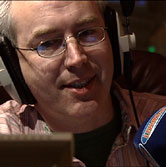
DJ Ed Myers of Limerick’s 95 FM addresses many dilemmas in modern-day Ireland: housing prices, immigration and the decline of Catholicism. Credit: Ronan Fox |
Mad-for-it Nation
If there is one thing the full-on nation is not demure about, it is our boozing that is now off the scales. We are heroic drinkers, and Ireland is the only place on earth where mature family men boast like students about necking 10 pints the night before. Drinking is an Irish badge of honor. It knows no class barriers. Rich and poor — we are all guzzlers. In fact, it is fair to say that many of us are suspicious of nondrinkers, particularly if they are not recovering alcoholics. Immigrants, many of whom now work behind our bars, are shocked by the sight of teenagers vomiting in the loos, wiping themselves, putting on a bit of lippy, marching back to the bar and ordering another double vodka and Red Bull. Twenty-five years ago we spent € 3.4 billion ($4.4 billion) on booze, but that figure has almost doubled and now the nation is spending an astonishing € 6.5 billion ($8.2 billion) annually on the demon drink. And it is not just stout and whiskey, although the stout figures are startling. We spent € 1.6 billion ($2.0 billion) on stout, which is 20 percent of the entire global market, but is some € 400 million ($505 million) more than the total Department of Education budget for all primary school education in this country. Wine drinking has skyrocketed. We now drink more beer than the Germans, far more alcohol than the supposedly alcoholic Russians. We are on a national bender; we spend more in restaurants, more in off-licenses and at the bar than anyone else.
When it comes to drink and drugs we are Keith Richards, Axl Rose, and Brendan Behan all rolled into one explosive mix. Young Irish women drink not twice or three times but 10 times more than their Italian equivalents. Four out of five of our young men are regular drinkers, compared to 34 percent of the EU average. We drink more pure alcohol than anyone else in the world, at 25.3 pints on average per person per year. That is three times more pure distilled alcohol than we have blood in our veins. It’s a wonder we are still alive.
And one of the most significant developments is that we drink considerably more than anyone else despite alcohol being very expensive here and, as prices have gone up, we have drunk more! So, not for the first time, the laws of economics are turned on their heads in Ireland. Our sociability gets the better of us always. We love going out. Four drinks out of five are sunk in the pub and, remarkably, when we don’t go out, we don’t tend to drink heavily at home. This contrasts with the rest of the world, where people drink mainly in the privacy of their own home. In beer-guzzling Germany, for example, only one third of all booze is drunk in bars. The Irish are desperately addicted to company as well as alcohol. We can’t stand being on our own.
But, just in case you thought we weren’t messy enough, we are necking Es like Smarties. The UN claims that the Irish are the second biggest users of ecstasy in the world after the Aussies. The price of ecstasy has dropped dramatically, and it is the drug of choice for the new generation. When ecstasy first arrived on the scene it cost € 20 ($25) a tab. It now costs € 5 ($6.3), or a dozen for € 50 ($63), which is considerably cheaper than a gin and tonic. But it’s not limited to teenagers. The middle youth generation, who simply won’t grow up, are at it big time. Many 40th birthday parties have been kept rocking due to liberal amounts of ecstasy being munched by respectable professionals. Biology suggests that 40-year-olds rarely last till dawn unless, of course, they are powdering their noses. Again the price of cocaine has dropped precipitously, and a recent RTE “Prime Time” documentary indicated that 80 percent of suburban loos had traces of chopped lines on their surfaces.
We eat more chips than the British. We eat more chocolate than the Belgians — in fact, we are third in Europe for chocolate munching. And, remarkably, we spend more on snacks than prescribed medicines. And for a nation that proudly claims to read more newspapers than any other, we actually spend more in the bookies than we do on newspapers. The punter nation is now gambling 24/7. Horse racing is the fastest growing sport in the country and its handmaiden, gambling, is booming. We are betting, squaring, laying, accumulating, forecasting, spread betting, calculating, winning and losing fortunes every day. Shares in Paddy Power the bookmaker are trading at 20 times earnings, which implies that even the stock market sees massive growth in this business over the coming years.
Any objective chronicler would deduce that if we are being so hedonistic, we must also be indolent, lazy, and work-shy. Nothing could be further from the truth. Miraculously, the Irish are the most productive workforce in the world.
A recent survey by O2 of the Irish self-employed found that we are workaholics: 60 percent of the bosses are working more than 40 hours a week and 13 percent of them work more than 63 hours a week. Just under half miss special family occasions such as weddings, anniversaries, birthdays, or communions because of work. Four out of five work weekends, and 43 percent do not take their full annual leave entitlement. Half of Irish bosses claim that their way of relaxing is the healthy activity of vegging in front of the TV, while one in three go drinking in the pub and a quarter go shopping. Irish workers are also slaving. The average worker puts in more hours per week than any other Europeans apart from the Brits. One in 12 has at least two jobs, which is well above the EU average, and because we spend twice as long commuting, the work experience, particularly for commuters, is typically eating up about 10 to 12 hours of our day. Many workers leave before seven and get home after seven.
When we are not working, we are changing jobs. Over 100,000 of us will sell ourselves, doctor our CVs, inflate our past experience, and lie about our achievements next year. This is because one in every 20 of us will change jobs, and practically all of us will be moving upwards. Our papers bulge with ads luring us to other challenges that always offer breadth, depth, complexity, always demand high performance, and always promise substantial rewards for the right candidate who is always accomplished, a good team player, and flexible. These recruitment ads sound more like a lonely hearts column than a job spec. Interestingly, after property ads, they generate more money for newspapers than any other category.
Although we are working harder in the full-on nation, it is the Irish women who are working much harder than ever. Since the late 1980s the number of women working has more than doubled (116 percent), while the number of men has gone up, but only by 43 percent. Women are obsessively front-loading their careers, which means they are working extremely hard in their twenties to try and scurry up the corporate ladder and are postponing having children until much later. The average age of an Irish mother giving birth this year is 30 and seven months — the oldest in the EU. Even before the kids arrive, we are sleeping less and drinking more Red Bull — last year we spend over € 100 million ($126 million) on energy drinks — to keep us awake.
Overhyped, Overspent, and Overdrawn
According to one IRISH TIMES report, the arrival of the Hermes handbag store in Brown Thomas was welcomed by someone enthusing that “it was a great day for the country!” It is clear that Ireland is a shopaholic nation with an insatiable appetite for newness. This year we will spend € 70 billion ($88 billion) consuming. That is over € 20,000 ($25,000) or close to three quarters of the average industrial wage for every man, woman, and child in the country! And when we are not actually out elbowing competitors aside in superstores or boutiques, we are talking about shopping, reading about shopping, and thinking about shopping. The range of what tickles our fancy is quite astonishing. For example, we must have some very pampered dogs out there, as we spent € 125 million on pet food last year. We forked out € 50 million ($158 million) on Chinese savoury sauces, € 18 million ($22.7 million) on hair dye, and € 23 million ($29.1 million) on Mars bars. We spend five times more on hula hoops than we do purchasing textbooks for children from needy backgrounds, and we splash out more on Coca-Cola — € 115 million ($145 million) than we do on the entire school transport bill, which carried 130,000 children to and from school every day. We spent more on our mobile phones in the first three months of the year than the entire annual budget for overseas development aid. We spend more on the rather adolescently pungent Lynx than we donate to Trocaire!
And we are spending when we are traveling. As recently as 2000, Ireland had a healthy surplus when it came to tourist spending. Tourists here spent much more than we did when we went on our holliers. By 2003, that had reversed. We now spend € 4.2 billion ($5.3 million) on our holliers, while tourists here in this, the most expensive country in Europe, are spending € 4.1 billion ($5.2 million). We are spending more in total, even though we are traveling to countries that are much cheaper than Ireland — some achievement!
And how are we financing this? Through debt, of course. This year, Ireland’s total personal debt surpassed our income for the first time ever. And it is rising rapidly. By the end of 2005, it will be in the region of 130 percent. In the 10 years to 2004, credit card use doubled to 33 percent and cash card use has increased from 40 percent to 60 percent of the population. And, as a recent central bank report noted, using credit cards allows us to juggle bills, paying a bit off here and a bit off there. Bill juggling is a new development. When you think that the older population will not be using credit cards as much, you can see that our most productive generation — those between 20 and 40 — are moving rapidly into levels of debt that would concern outsiders looking in. But us, we don’t care, because we believe our own propaganda that this time it’s different. So borrowing continues apace. We borrowed 25 percent more in 2005 than we did in 2004. And we are spending this cash on flashy items. In the past four years, the market share of BMWs and Mercs has doubled, from 3.6 percent to 6.2 percent. We are Europe’s bling nation. Per head, there now are more Mercs sold here than in Germany. The two big banks — our principal moneylenders — are, as a result of our splurge, the most profitable in Europe, making around € 350 ($442) profit per customer.
If we are not being full-on, we are doing more yoga to relax. This is one of the delicious paradoxes of modern Ireland. While we seem intent on obliterating our livers, kidneys, and hearts by drinking and carousing, we are also in the grip of a health kick. We are fussier about what we eat, flocking to nutritionists and homeopathic practitioners, taking more echinacea, devouring advice on healthy options, taking more Prozac, and spending € 21 million ($26.5 million) on L’Oreal skin cream. The same people who are snorting coke and drinking a couple of bottles of Chablis each on Friday nights are fretting about food additives and won’t take an Anadin for their headaches. We will drink seven gins but won’t touch tap water. We will feed our hangovers with carbohydrates but then, when fully rehydrated and sober, regard mashed potatoes as the devil’s spawn. We sit in our cars from early morning, eating an amazing 17 percent of all of our food at the dashboard — most new cars now come with pull-out dining trays. We then slouch at our desks all day, order in lunch, careful to avoid any physical activity at all. We leave work, catch our reflection in the tinted windows of our BMW x series SUV, and then fret about being overweight, unhealthy, or not beautiful. So we drive to the gym or the health club. Instead of going for a regular stroll every evening, we get a personal trainer at the appropriately named Curves gym for one manic morning a week. The Golden Pages has over 2,000 entries under health clubs and centers.
The full-on nation is burning the candle at both ends.
David McWilliams is an Irish economist, author and commentator. To read more about him, visit his Web site at http://www.davidmcwilliams.ie/. For more information about THE POPE’S CHILDREN, visit publisher Gill & Macmillan.

